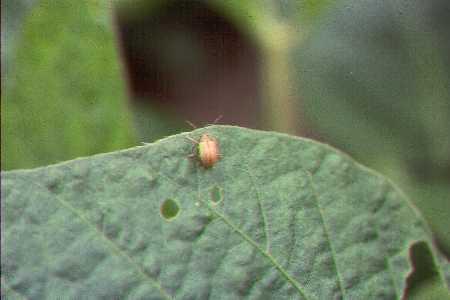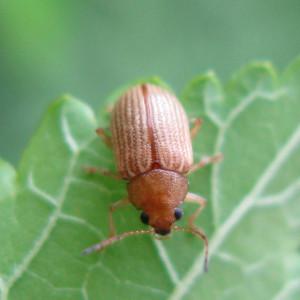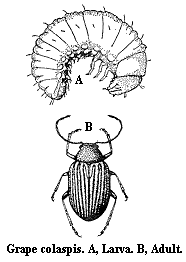Grape Colaspis
- Scientific Name(s)
- Colaspis brunnea
- Type
- Insect
- Leaf Condition
- Lace Like Skeleton, Chewing Damage
- Roots
- Stunted, Chewing Or Boring Damage
- Plant Size
- Stunted
- Field Distribution
- Localized Area
- Prior Environmental
- Organic Soil
- Cropping System
- Soybean Followed By Soybean
Identification
Grape colaspis – Colaspis brunnea (Fabricius), Chrysomelidae, Coleoptera
Adult – The oval, yellowish-brown beetle is 4 to 5 mm long. The wing covers appear striped due to the presence of longitudinal rows of shallow indentations.
Egg – The smooth, white to yellow egg is about 0.6 by 0.25 mm.
Larva – Measuring up to 7 mm long, the grayish-white or tan larva has a dark brown head and prothoracic shield. It is stout and grub-like in form with three pairs of legs near its head and fleshy appendages on the abdominal segments.
Pupa – Whitish at first, the 4 mm-long pupa gradually darkens.
Injury and Damage
Grape colaspis are harmful to soybean as grubs. They can injure plants by root feeding; damaged seedlings have few lateral roots and the underground stem may show feeding on the bark. Seedlings may die or be stunted from the feeding. Grape colaspis damage is often wrongly interpreted as nematode damage. However, it can be identified by the characteristic root and stem feeding signs. Often the presence of the adult beetles, which can feed in the plant’s foliar terminals, will aid problem identification. Foliage feeding by the emerged adults is insignificant. This insect will almost always be restricted to spots in the field and is most abundant on organic soils.
Economic threshold and management
Grape colaspis passes the winter in the soil as a grub (larva) from the previous season. Typically, the adults will only lay eggs in legume plantings (e.g. soybean) during the previous season and, therefore, if current year soybean seedlings are to have a problem, they must follow last year’s soybean crop. After overwintering below the plow layer, grape colaspis grubs move near the surface in later May and feed on seedling roots. The grubs are small (to 5⁄16 inch), “C” shaped, white larvae with a brown head capsule and neck shield. Damaged seedlings have few lateral roots and the underground stem may show feeding on the bark. Seedlings may die or be stunted from the feeding. This insect will almost always be restricted to spots in the field and is most abundant on organic soils. Grape colaspis damage is often wrongly interpreted as nematode damage; however, it can be identified by the characteristic root and stem feeding signs. Often the presence of small, light brown adult beetles (less than 1⁄4 inch) feeding in the plant terminals will aid problem identification. However, foliage feeding by the emerged adults is insignificant.
There is no remedial treatment, and insecticides are ineffective to manage this insect. Hence, there is no economic threshold for grape colaspis. Since adults lay eggs in the previous season’s soybeans, rotation is the best option to eliminate grape colaspis problems. That being the case, soybeans replanted the same year are seldom attacked since the larva responsible for the original injury will have developed into beetles and emerged. Tillage is ineffective because larvae can overwinter below the plow layer. Replanted soybeans are seldom attacked because the larvae responsible for the original injury will have developed into beetles and emerged.





